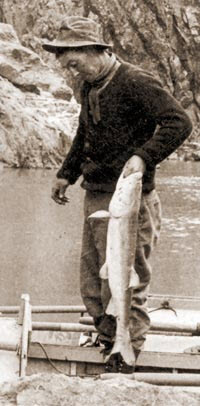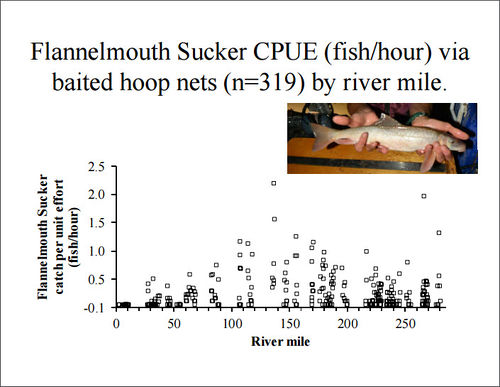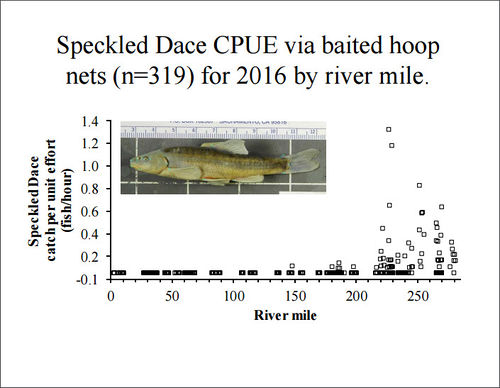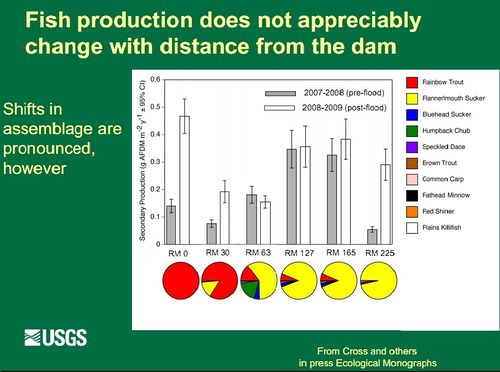FISH
|
|
Other Native FishGrand Canyon was once home to eight species of native fish. Only five of these species are found in the park today. Following the completion of Glen Canyon Dam in 1963, the fish assemblage in the Colorado River in Grand Canyon has shifted to a non-native rainbow trout fishery in the stretches of river closest to the dam and above the Little Colorado River. Of the canyon's native fish species, only speckled dace remain truly common in the park, and they live primarily in tributaries which retain their natural characteristics more than the Colorado River. Two species of Grand Canyon's native fish are listed under the Endangered Species Act. Humpback chub, which used to be abundant in Grand Canyon, has been listed as an endangered species since 1967. Razorback Suckers are very rare in the canyon, and were listed as endangered in 1991. Grand Canyon has a very distinctive collection of native fish. All eight native species belong to only two families: minnows (Cyprinidae) and suckers (Catostomidae). Six of the eight native species are found only in the Colorado River basin. This very high percentage of endemic fish species likely results from the geographic isolation of the Colorado River system, and the highly variable natural environments, flow and temperature regimes of the river and its tributaries. The Colorado River has the lowest diversity of native fish and the highest level of endemism of any river system in North America. The river's unusual native fish assemblage is as iconic a characteristic of Grand Canyon as its towering cliffs and spectacular scenery.[1] LTEMP Resource Goal for Other Native FishMaintain self-sustaining native fish species populations and their habitats in their natural ranges on the Colorado River and its tributaries. Desired Future Condition for Native Species and Biotic CommunitiesNative Species: |
| |
Fish of the Colorado River below Glen Canyon Dam - GCDAMP training prepared by AZFGD |
|
|---|
Native Fishes of Grand Canyon (Grand Canyon River Guides)HUMPBACK CHUB (Gila cypha)Found as one population in Grand Canyon. Characterized by an abrupt fleshy hump behind the head, that starts developing when the fish is about 6 inches long, and becomes more pronounced with age. Color is a slate gray/green back with silvery sides and a white belly. Matures at about 3 years of age and can live up to 30 years. Maximum size about 20 inches and 2 1/4 pounds. Spawning occurs in spring following peak runoff; females broadcast about 2,000 tiny sticky eggs over gravel/cobble bottom. Transparent larvae (1/3" long) hatch in 5 days and grow to about 3 inches in one year. Found in only six locations in canyon areas of the Colorado River Basin in Colorado, Utah, and Arizona (Grand Canyon, Westwater Canyon, Black Rocks, Cataract Canyon, Desolation Canyon, Yampa Canyon). Is a federally “endangered species” with major threats from flow depletion, altered water chemistry, flooded habitat from reservoirs, introduced parasites and diseases, competition and predation from introduced non-native fish, and possible hybridization with roundtail chub and bonytail due to breakdown of reproductive isolating mechanisms. RAZORBACK SUCKER (Xyrauchen texanus)Extremely rare in Grand Canyon. Named for the ridge-like bony keel on the back that first appears when the fish is about 6" long. Color is a dark green/brown back with olive sides and yellowish-white belly. The fleshy mouth is used to feed on insects and algae in the drift and on the river bottom. Matures at about 3 years of age and can live over 40 years. Maximum size about 3 feet and 13 pounds. Spawn in spring during peak runoff on gravel bars; females broadcast up to 100,000 tiny sticky eggs that hatch in about 5 days into transparent larvae (1/3" long) and grow to about 6 inches in one year. Found in the Colorado, Green, Yampa, White rivers of the upper basin, as well as the Gila, Salt, Verde rivers of the lower basin, with greatest numbers in Lake Mohave. Very rare in the Grand Canyon. Is a federally “endangered species” with major threats from flow depletion eliminating flooded bottoms, altered water chemistry, flooded habitat from reservoirs, introduced parasites and diseases, competition and predation from introduced non-native fish. FLANNELMOUTH SUCKER (Catostomus latipinnis)Found in small numbers in Grand Canyon. Similar in appearance to the razorback sucker but with no prominent bony keel. Color is an olivaceous back with brownish-yellow sides and a creamy belly. The fleshy mouth hangs prominently with many small protrubances used to gather insects and algae from drift and the river bottom. Matures in 3-4 years and attains a maximum size of about 20 inches and 5 pounds. Spawn in late spring over gravel bars; females broadcast sticky eggs that are fertilized by numerous males. Transparent larvae (1/3" long) hatch in about 5 days and can drift for great distances downstream to nursery backwaters. Common in some reaches of the Colorado and Green rivers and their tributaries in the upper basin, with fewer numbers in the lower basin. Common but decreasing in number in Grand Canyon. Protected by the States of Colorado, Utah, New Mexico, Arizona, California, and a federal “candidate species” - possible for consideration as an endangered or threatened species. Major threats from flow depletion, altered water chemistry, flooded habitat from reservoirs, introduced parasites and diseases, competition and predation from introduced non-native fish, and hybridization with introduced white suckers. BLUEHEAD SUCKER (Catostomus discobolus)Found in small numbers in Grand Canyon. A more slender, torpedo-shaped sucker than the flannelmouth or razorback. Has small body scales near the head that gradually increase in size toward the tail. Color is a gray/blue back fading to a whitish belly, often with a rosy band along the side of the body. The fleshy mouth has a sharp ridge or “radula” on the lower jaw that enables this fish to scrape insects, algae and diatoms directly off rocks for food. Can inhabit swift rocky areas, and can be seen in spring spawning runs in very shallow swift water (e.g., Shinumo, Kanab creeks). Matures at 3-4 years and attains a maximum size of 16 inches and 1 1/2 pounds. Females broadcast sticky eggs over gravel/cobble. Transparent larvae (1/3" long) hatch in about 5 days and can drift for great distances downstream. Common in some reaches of the Colorado and Green rivers and their tributaries in the upper basin with fewer numbers in the lower basin. Decreasing in numbers in Grand Canyon. Also found in other rivers in western North America. Protected by the States of Colorado, Utah, New Mexico, Arizona, California. Major threats from flow depletion, altered water chemistry, flooded habitat from reservoirs, introduced parasites and diseases, competition and predation from introduced non-native fish, and hybridization from introduced white suckers. COLORADO PIKEMINNOW (Ptychocheilus lucius)Extirpated from Grand Canyon. Once the top predator of the Colorado River, known as the “white salmon of the Colorado River”. Slender body with light green back, silvery sides, and white belly. Young fish often have a black diamond-shaped spot at the base of the tail. Documented length of 4 feet and weight of 30 pounds in the wild, with evidence of fish up to 6 feet long weighing 80 pounds. Largest captured recently was 3 feet long and weighed 20 pounds. The genus Ptychocheilus means “folded lip” and the species name lucius means “pike”. Colorado pikeminnow have large lips with no teeth on jaws, tongue, or palate, but sharp jagged throat teeth (pharyngeal teeth) that rake and tear swallowed prey. They are primarily piscivorous (fish eaters), but will take insects, small mammals, and birds. Mature at 4-5 years of age, and may live to 30 years. Once inhabited the warm regions of the Colorado River and its tributaries, now limited as wild populations to the Colorado, Green, Yampa, Gunnison, White, and Dolores rivers in the upper basin, and reintroduced in some rivers of the lower basin (Verde, Salt). Females broadcast up to 75,000 tiny sticky eggs over cobble and gravel during June and July that hatch in about 5 days. Tiny larvae (1/3 inch long) drift into backwater nurseries where they remain for most of their first year of life. Young pikeminnow are slender, silvery, and may resemble young chubs. Colorado pikeminnow have a larger mouth—upper jaw extends past the center of the eye—while chubs have smaller mouths with the jaw extending only to the front of the eye. The Colorado squawfish is a “federally endangered species” because large mainstem dams have blocked migration routes, inundated habitat, and altered flow regimes. Related species include the northern pikeminnow (Columbia River), Sacramento pikeminnow (Sacramento-San Joaquin rivers), and Umpqua pikeminnow (Umpqua-Suislaw rivers). BONYTAIL (Gila elegans)Extirpated from Grand Canyon. Characterized by a longer slender tail trunk and tail fins, slender body, and small eye. Color is a gray back with silvery sides, black diffused specks, and a white belly. Matures at about 3 years of age and can live up to 30 years. Maximum size about 24 inches and 3 pounds. Spawning occurs in late spring; females broadcast about 4,000 tiny sticky eggs over gravel/cobble bottom. Transparent larvae (1/3" long) hatch in 5 days and grow to about 3 inches in one year. This is the rarest of the Colorado River mainstem fishes. Found in small numbers in Lake Mohave, and as isolated individuals in Black Rocks, Cataract Canyon, and Desolation Canyon in upper basin. Is a federally “endangered species” with major threats from flow depletion, altered water chemistry, flooded habitat from reservoirs, introduced parasites and diseases, competition and predation from introduced non-native fish, and possible hybridization with roundtail chub and humpback chub due to breakdown of reproductive isolating mechanisms. ROUNDTAIL CHUB (Gila robusta)Extirpated from Grand Canyon. Related to the endangered humpback chub and bonytail, but not a federally endangered species. Characterized by a robust body and tail trunk. Color is a green back with silvery sides, and a white belly. Matures at about 3 years of age with life expectancy unknown. Maximum size about 18 inches and 2 pounds. Spawning occurs in late spring; females broadcast about 2,000 tiny sticky eggs over gravel/cobble bottom. Transparent larvae (1/3" long) hatch in 5 days and grow to about 3 inches in one year. Found in most tributaries of the Colorado River basin and in some mainstem areas, but rapidly decreasing in numbers. Can be found in aggregations along eddy lines feeding on drifting insects. Major threats from flow depletion, altered water chemistry, flooded habitat from reservoirs, introduced parasites and diseases, competition and predation from introduced non-native fish, and possible hybridization with humpback chub and bonytail due to breakdown of reproductive isolating mechanisms. SPECKLED DACE (Rhinichthys osculus)Common in Grand Canyon. The smallest of the mainstem Grand Canyon fishes, attaining a maximum size of about 5 inches. Body is cylindrical with a tapered head and snout. Color is variable from dusky yellow to speckled with a bright orange lateral band. The consistent characteristic is a black lateral face band running from the snout through the eye. Common in riffles, shorelines, backwaters, and tributaries in Grand Canyon. Spawn in tributaries in spring and summer. Feed on small insects and crustaceans, and their small size provides a readily available food source for predaceous fish in Grand Canyon, such as large trout and channel catfish. Speckled dace appear widespread in the Colorado River basin and throughout the western U.S., but their status and population trends are unknown. © 1993 Written by Richard A. Valdez, Ph.D. BIO/WEST Illustrated by M. C. Filbert. Produced by Grand Canyon River Guides, Inc. Additional copies available for $3 each or 2 for $5, postpaid, from: GCRG, P.O. Box 1934, Flagstaff, AZ 86002. (602) 773-1075 |
|



